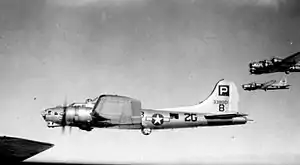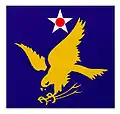836th Bombardment Squadron
The 836th Bombardment Squadron was a United States Army Air Forces unit. It was activated in September 1943. After training in the United States, it deployed to the European Theater of Operations , where it engaged in combat in the strategic bombing campaign against Germany with Consolidated B-24 Liberators. In the summer of 1944, it was withdrawn from combat to convert to the Boeing B-17 Flying Fortress, then continued in combat with the 487th Bombardment Group until the spring of 1945. Following V-E Day, the squadron returned to Drew Field, Florida, where it was inactivated on 7 November 1945.
| 836th Bombardment Squadron | |
|---|---|
 836th Bombardment Squadron B-17 Flying Fortress[note 1] | |
| Active | 1943–1945 |
| Country | |
| Branch | |
| Role | Bombardment |
| Engagements | European Theater of Operations |
History

The 836th Bombardment Squadron was activated at Bruning Army Air Field, Nebraska on 20 September 1943 as one of the original squadrons of the 487th Bombardment Group. The squadron trained with Consolidated B-24 Liberators until March 1944, when it departed for the European Theater of Operations.[1][2] The ground echelon left Alamogordo Army Air Field, New Mexico on 10 March 1944 for the port of embarkation at Camp Kilmer, New Jersey, sailing on the SS Duchess of Bedford and arrived in Great Britain on 3 April. The air echelon departed via the southern ferry route on 23 March.[3]
The squadron arrived at RAF Lavenham, its base in England, on 4 April 1944, with the air echelon arriving between 13 and 17 April. The 836th entered combat on 7 May 1944,[3] bombing airfields in Normandy in preparation for Operation Overlord. During the landings, the squadron struck coastal defenses, road junctions, bridges and rolling stock. It supported British troops near Caen by attacking German troops and artillery redoubts and made similar attacks to support troops assaulting Brest. It provided support for Operation Market Garden, the attempt to seize bridgeheads across the Rhine River near Arnhem and Nijmegen in the Netherlands.[2]
Because of its involvement with tactical operations, the squadron engaged in only limited strategic operations with the Liberator. On 19 July 1944, the squadron was taken off combat operations, along with other units of the 92d Combat Bombardment Wing, to convert from the Liberator to the Boeing B-17 Flying Fortress, in a move that would transform the 3d Bombardment Division to an all Flying Fortress organization.[4][3] After completing the transition to the B-17 on 1 August 1944,[3] the unit began to focus on strategic targets until March 1945. It attacked oil refineries in Merseburg, Mannheim and Dulmen; factories in Nuremberg, Hanover and Berlin; and marshalling yards in Köln, Münster, Hamm and Neumunster.[2]
On 24 December 1944, the squadron was the lead squadron on Eighth Air Force's largest mission of the war.[note 2] Brigadier General Frederick Castle, commander of the 4th Bombardment Wing commanded the raid and flew the 836th's lead aircraft. The formation was attacked by Luftwaffe interceptors before escorting fighters could join the bombers. Among the losses caused by this attack was General Castle's lead plane. He was awarded the Medal of Honor for taking control of the plane to permit other crewmembers to bail out and refusing to jettison the plane's bombload to avoid casualties to civilians or friendly troops below.[5][6]
The squadron was diverted from the strategic bombing campaign to support ground troops during the Battle of the Bulge from December 1944 to January 1945. It also flew interdiction missions during the Allied crossings of the Rhine and final thrust across Germany.[2] It flew its last combat mission on 21 April 1945.[3]
The squadron remained in England after V-E Day. The air echelon began to fly their B-17s back to the United States in the last week of July, while the rest of the unit returned to the United States on the RMS Queen Elizabeth in August.[3] It reassembled at Drew Field, Florida in September and was inactivated there on 7 November 1945.[1]
Lineage
- Constituted as the 836th Bombardment Squadron (Heavy) on 14 September 1943
- Activated on 20 September 1943
- Redesignated 836th Bombardment Squadron, Heavy c. 1944
- Inactivated on 7 November 1945[1]
Assignments
- 487th Bombardment Group, 20 September 1943 – 7 November 1945[1]
Stations
Aircraft
- Consolidated B-24 Liberator, 1943–1944
- Boeing B-17 Flying Fortress, 1944–1945[1]
Campaigns
| Campaign Streamer | Campaign | Dates | Notes |
|---|---|---|---|
| Air Offensive, Europe | 4 April 1944–5 June 1944 | 836th Bombardment Squadron[1] | |
| Air Combat, EAME Theater | 4 April 1944–11 May 1945 | 836th Bombardment Squadron[1] | |
| Normandy | 6 June 1944–24 July 1944 | 836th Bombardment Squadron[1] | |
| Northern France | 25 July 1944–14 September 1944 | 836th Bombardment Squadron[1] | |
| Rhineland | 15 September 1944–21 March 1945 | 836th Bombardment Squadron[1] | |
| Ardennes-Alsace | 16 December 1944–25 January 1945 | 836th Bombardment Squadron[1] | |
| Central Europe | 22 March 1944–21 May 1945 | 836th Bombardment Squadron[1] |
See also
References
Notes
- Explanatory notes
- Aircraft is Boeing B-17G-75-BO Flying Fortress, serial 43-38001. it was shot down by anti-aircraft artillery over Czechoslovakia on 17 April 1945. All crewmembers parachuted to safety and were made Prisoners of War.
- Eighth Air Force launched 2,034 bombers on this raid and was joined by an additional 500 from the Royal Air Force and Ninth Air Force. Freeman, p. 201.
- Citations
- Maurer, Combat Squadrons, p. 775
- Maurer, Combat Units, pp. 357–358
- Freeman, p. 260
- Freeman, p. 172
- Freeman, p. 201.
- "Combat Missions". 487th Bomb Group (H) Association. Retrieved 12 November 2018.
- Station number in Anderson, p. 21.
- Station information in Maurer, Combat Squadrons, p. 775, except as noted.
Bibliography
![]() This article incorporates public domain material from the Air Force Historical Research Agency website http://www.afhra.af.mil/.
This article incorporates public domain material from the Air Force Historical Research Agency website http://www.afhra.af.mil/.
- Anderson, Capt. Barry (1985). Army Air Forces Stations: A Guide to the Stations Where U.S. Army Air Forces Personnel Served in the United Kingdom During World War II (PDF). Maxwell AFB, AL: Research Division, USAF Historical Research Center. Archived from the original (PDF) on 23 January 2016. Retrieved 28 June 2017.
- Freeman, Roger A. (1970). The Mighty Eighth: Units, Men and Machines (A History of the US 8th Army Air Force). London, England, UK: Macdonald and Company. ISBN 978-0-87938-638-2.
- Maurer, Maurer, ed. (1983) [1961]. Air Force Combat Units of World War II (PDF) (reprint ed.). Washington, DC: Office of Air Force History. ISBN 0-912799-02-1. LCCN 61060979. Retrieved 17 December 2016.
- Maurer, Maurer, ed. (1982) [1969]. Combat Squadrons of the Air Force, World War II (PDF) (reprint ed.). Washington, DC: Office of Air Force History. ISBN 0-405-12194-6. LCCN 70605402. OCLC 72556.
